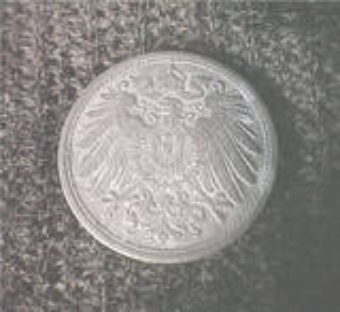Collecting German Coins

German Empire 1871-1918


Learn History of Germany Through Coins
From 1871-1945, Germany was a successful empire - with land comprising 208,780 square miles.
As a republic and a totalitarian state, Germany became one of the greatest powers in the world.
The Empire era of Germany was 1871-1918 and its ruler was Kaiser Wilhelm II from 1888-1918 when he abdicated.
The coin shown is a German 10 pfennig, comprised of copper-nickel, and is dated 1918.
The coin's inscription "Deutsches Reich" translates to "German Empire."
If this 1918 coin was stamped with the letter D (for Munich), the value could range from $300-$1150.
Weimar Republic 1919-1933


Learn About Germany After World War I
Because of the German Empire's defeat in WWI and the enormous cost of repaying for the damage the war had caused, the economy of Germany was negatively affected.
A large portion of the male population was killed during the war and so women became essential to rebuilding the country by entering the workforce.
President Ebert was the first ruler of the Weimar Republic in post World War I.
The coin shown is a German 10 rentenpfennig, comprised of aluminum-bronze, and is dated 1924 E (minted in Muldenhutten).
The coin's inscription "Deutsches Reich" translates to "German Empire" and remained the official name of Germany.
Third Reich 1933-1945


Learn About Hitler's Reign
Adolph Hitler gained power in 1933 after Germany's defeat in WW I and its economic downturn. He reconstituted Germany as the Third Reich which brought some diplomacy and initial military success.
V-E Day (Victory in Europe Day) on May 7, 1945 ended the horrific reign of Hitler.
The coin shown is a German 50 reichspfennig, comprised of aluminum, and is dated 1941 A (minted in Berlin).
The interesting design on this particular coin is the swastika being held in an eagle's talons.
The coin's inscription "Deutsches Reich" translates to "German Empire" which remained the official name for Germany.
Allied Occupation Coins


Learn About East and West Germany
Germany was divided into Federal Republic (West Germany), German Democratic Republic (East Germany) and Berlin from 1949-1990.
The image on the German 2 mark copper-nickel coin shown is Konrad Adenauer who was the chancellor of West Germany from 1949-1963.
Note: The design on the reverse side of the 2 mark coin dated 1969 D (minted in Munich) was modified by removing the swastika below the eagle.
The inscription "Bundesrepublik Deutschland" translates to "Federal Republic of Germany."
German Democratic Republic


Learn About GDR 1949-1990
The Soviet Union ceased its occupation of East Germany-including East Berlin-and established the territory as the Democratic Republic of Germany on October 7, 1949.
The coin shown is a German 10 pfennig, comprised of aluminum and is dated 1971 A (minted in Berlin).
It is inscribed "Deutsche Demokratische Republik" which translates to "German Democratic Republic" or "GDR" in English.
United Germany


Learn About Post 1990 Germany
On October 3, 1990 West Germany and the GDR were united into one Germany.
It has been called a united (or re-united) Germany.
The coin shown is a German 10 pfennig, comprised of brass plated steel, and is dated 1993 D (minted in Munich).
The inscription "Bundesrepublik Deutschland" translates to Federal Republic of Germany.
All coin photos in this article were taken by the author, Camille Gizzarelli.
European Union
These German coins were pre EU when the European countries had their own currency. Then the European Union was formed in 1951 and 1958 when only one currency, the euro would be used.
Now in 2016 it appears that there is a possibility that some of the European countries may want to leave the European Union and become more nationalistic.
Will they return to minting their own coins, once again? Only time will tell.
My Other Hubpages Articles on Collecting Coins
© 2010 CamilleGizzarelli








